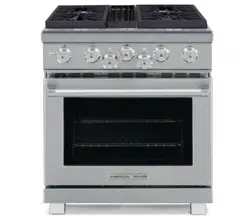Loading ...
Loading ...
Loading ...

26
4580 N. Walnut Rd., N. Las Vegas, NV 89081
|
13592 Desmond St., Pacoima, CA 91331
|
tel: 818.897.0808
|
888.753.9898
|
www.AmericanRangeHome.com
COOKWARE RECOMMENDATIONS
To avoid the risk of serious injury, damage to the range or
cookware, please observe the following guidelines.
Bakeware, such as large casserole pans, cookie sheets, etc.,
should never be used on the cooktop.
Placement of large stock pots should be staggered when used
on the cooktop.
Select the base diameter of the pot to match the diameter
of the ame. The diameter of the ame and the diameter
of the pan bottom should match or be slightly smaller. Too
large or too small pots on a burner will compromise cooking
performance.
Do not place food packaged or wrapped in aluminum foil
directly on the burner grate above the burner. Aluminum foil
can melt during cooking.
Be careful to not let plastic, paper or cloth come in contact
with a hot burner grate. These materials can catch re or melt.
Never let a pan boil dry – and if it occurs remember it can be
extremely hot – and very dangerous. If this should occur, turn
o the burner immediately. Wait a while, until the pot cools
down enough to handle – this could be several minutes, but
could save you from burns or other serious injury.
The pan bottom should be at, the heavier the better – and
well balanced on the cooktop grate – sitting at without
rocking – preferably with tight tting lids. Try not to slide the
pot across the grates – while it is very handy to do so – you
may end up scratching the pot or the grate.
Always be careful when using high ames, as in wok cooking,
as they may contact ammable materials or make the handles
of the wok very hot. Use the wok ring (optional) to stabilize
the wok.
SUGGESTED BURNER SETTINGS
HEAT SETTINGS USE
Simmer
Melting small quantities of butter,
simmer grains, rice, oatmeal
Low Poaching eggs, sh, poultry
Low to Medium Fry eggs, heat milk, cream sauces
Medium Puddings, custards, gravies
Medium to High
Sauté vegetables, braise meats, soups
and stews, deep fat frying, boiling water
and pasta, blanching vegetables, searing
meats
High
Large quantity of water to boil, large
quantity frying and cooking
OVENS 101
The oven is a temperature controlled cooking cavity which is highly
insulated to keep the kitchen cool the food hot. The oven contains
three elements – the Bake element positioned below the oven oor
and the Broil element located in the ceiling of the oven. Bake and
Broil are very dierent cooking operations and the elements are
designed to deliver energy in a way appropriate to the task.
There are two types of baking – called Standard Bake (or
conventional) and Convection Bake. Standard or conventional baking
make best use of Grandma’s cookie, cake or pie recipes – like bake
at 350ºF (177ºC) for forty-ve minutes – to get the job done. These
recipes are tried and true – conventional or standard bake will
deliver wonderful performance every time you cook.
When you Convection Bake (using a fan to circulate the high
temperature air inside the oven) you can lower the thermostat
about 25º and reduce the cook time by about 25% – and achieve
ne cooking results just like Grandma’s – taking less time and using
less energy. Use the same recommended temperatures for meats
and poultry dishes – but keep watch of the time. Convection
cooking technology was rst developed in Europe and has been
used for many years – recently taking hold in U.S. residential kitchens
and cookbooks.
In convection cooking, not only is the cook time faster, but also, the
oven temperature is more even, top to bottom and side to side
– so cookies on several racks will have the same brown color and
texture. However, to best take advantage of convection, use low,
shallow bakeware so that moving air can get over the sides and up
to the food surface. Foods in covered dishes (like casseroles or pot
roasts) do not benet from convection cooking.
OPERATING YOUR RANGE
COOLING FAN
The cooling fan runs on all cooking modes. The fan can be heard
when it is running and warm air can be felt as it release through the
oven vent. The fan will continue to run after the oven mode is o.
OVEN VENT
The oven vent is located at the bottom of the appliance. Warm air
may be released during and after cooking. DO NOT block the vent
as it is important for air circulation.
CONVECTION FAN
The convection fan operates during all convection modes and during
the preheat cycle of cooking modes. it will run intermittently on
ROAST.
OVEN BOTTOM
The oven bottom conceals the bake element. DO NOT place food
directly on the oven bottom. DO NOT use aluminum foil or liners
on the oven bottom, nor any part of the oven cavity.
Loading ...
Loading ...
Loading ...
